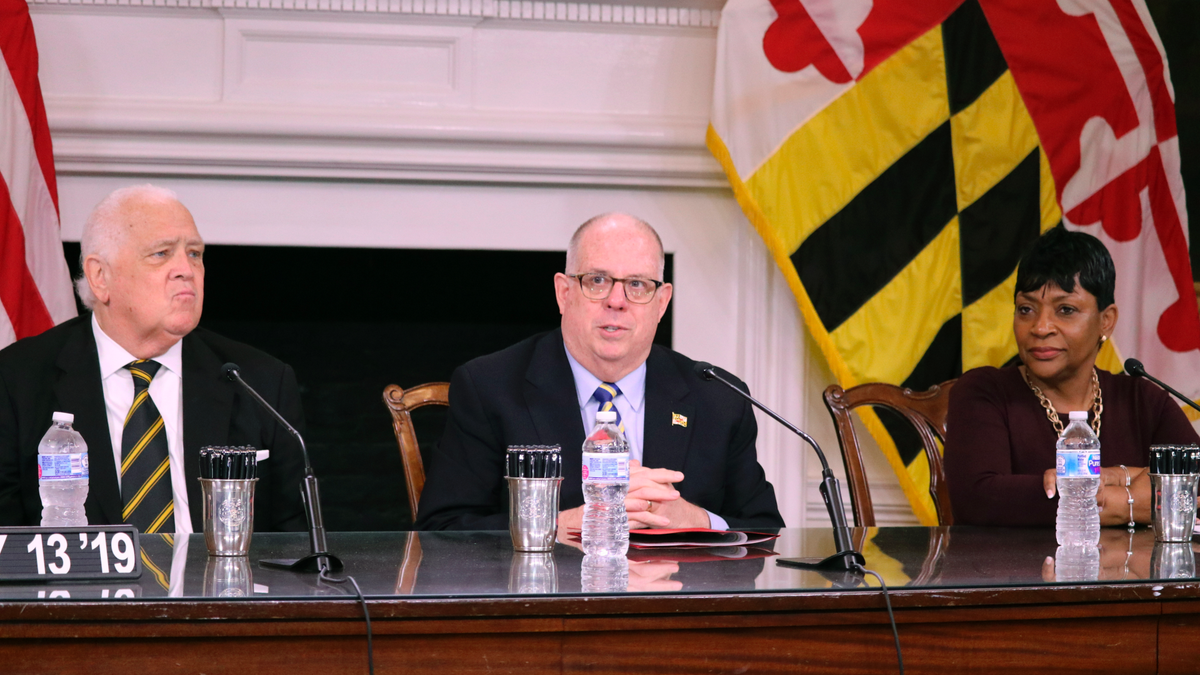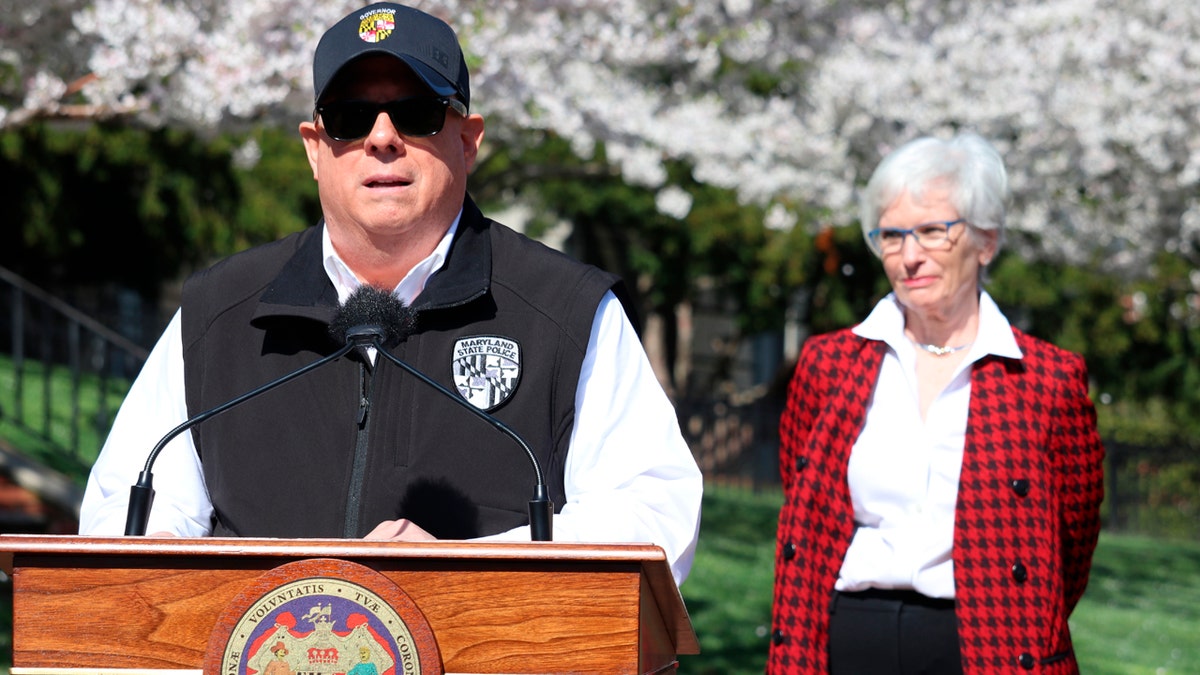Gov. Larry Hogan says COVID-19 is still escalating in Maryland
Maryland Gov. Larry Hogan weighs in on getting the economy back on track in a safe way and how the federal government is responding to his state's needs on 'America Together: Returning to Work.'
The Big Idea is a series that asks top lawmakers and officials to discuss their moonshot — what’s the one proposal, if politics and polls and even price tag were not an issue, they’d implement to change the country for the better?
For years, infrastructure reform has been one of the most popular issues among politicians and voters alike — political leaders regularly talk about the need for reform and a significant majority of the public have said they worry about the state of the nation's infrastructure.
It's been at the forefront of American politics for the better part of a decade, at least since former President Barack Obama introduced his "Vision for 21st Century Transportation Infrastructure" in 2014.
Now, House Speaker Nancy Pelosi, D-Calif., and President Trump have both said they want to address infrastructure in a future coronavirus relief bill in a project described by Senate Minority Leader Chuck Schumer, D-N.Y., as "Rooseveltian."

Maryland Gov. Larry Hogan highlights bipartisan efforts to improve health care in Maryland before signing legislation to help uninsured residents get health insurance and to raise the smoking age from 18 to 21 on Monday, May 13, 2019 in Annapolis, Maryland. (AP Photo/Brian Witte)
MARYLAND GOV DEFENDS CORONAVIRUS RESTRICTIONS: NONE OF US WANT TO BE LIKE CHINA OR ITALY
Yet, despite all the talk, the federal government has yet to pass a large-scale infrastructure reform bill that would address deficiencies in America's roads, bridges, dams, public transportation, internet and more.
The federal government has been at the center of the national infrastructure issue since former President Eisenhower led the charge to build the national interstate system in the 1950s. But there are some who would like states – which have been thrust into a leading role in the coronavirus crisis – to take the lead.
When Maryland Republican Gov. Larry Hogan assumed the chairmanship of the National Governors Association (NGA) in 2019, he started pushing for just that. As part of the effort to put governors in the driver's seat, the NGA has held stakeholder summits, highlighted infrastructure initiatives in individual states and even sent a delegation to Australia to study that country's infrastructure.
Hogan explained his big idea for infrastructure in a Q&A with Fox News.
When you assumed the NGA chairmanship, you put infrastructure as a top priority right away. Why was that?
Well, you know, America's crumbling infrastructure is probably the No. 1 problem that every single governor has been dealing with. And it's a problem that Washington has failed to solve.
And I thought it was an area where we could find some bipartisan agreement among the governors and so that's why we focused on that as a yearlong initiative.
Infrastructure is something that has been talked about for years, how is your plan different, particularly on states' roles?
The concept was, first of all, to just bring together all of the best ideas from the private sector, from the experts in the industries, from all of the governors both from red states and blue states, and from some of the smartest people in government at all levels, to say, 'How can we rethink infrastructure?' and providing infrastructure – not just transportation infrastructure – but on the grid, on rural broadband on all of our infrastructure.
MARYLAND'S HOGAN PUSHES BACK ON TRUMP'S CLAIM THAT STATES HAVE SUPPLIES TO FIGHT CORONAVIRUS
How do we rebuild infrastructure and deliver these things in a better way? Is there another way to look at it? Instead of a top-down waiting for Washington, it was like, 'Why don't the governors have a yearlong initiative to make some recommendations to Washington and to other governors about other things, other ways to look at this problem?'
How have past more federally centered approaches to infrastructure created obstacles to progress?
We just haven't had a federal infrastructure initiative in a long, long time. And so America's infrastructure has been crumbling. It's been something that everyone's talked about. I mean, the Trump administration has talked about infrastructure as a critical priority. And Democrats and Republicans in the House and the Senate have talked about it. But we haven't really made progress. So our focus was on four main areas, basically, relieving congestion to boost economic competitiveness, eliminating red tape and integrating smart technology, and then protecting America's critical infrastructure and leveraging private sector investment.
It's not all just about, you know, revenues coming in, raising taxes at the federal level. There's plenty of private sector investment dollars, public-private partnerships, P3's, that have been successful around the world in other places. And that's one of the ideas that we wanted to pursue.
States and governors, in particular, have taken center stage in the coronavirus crisis. What lessons can be learned from that and applied to dealing with infrastructure?

Maryland Gov. Larry Hogan announces a "stay-at-home" directive during a news conference on Monday, March 30, 2020, in Annapolis, Md. (AP Photo/Brian Witte)
WHO IS LARRY HOGAN? WHAT TO KNOW ABOUT MARYLAND'S GOVERNOR
First of all, I think the governors have led on the coronavirus crisis and the National Governors Association, I think, has had more relevance than ever, and governors have really stepped up.
But one of the things that's really happened is, I mean, the power of the states and the leadership of the governors has been more visible. But it's also been a really great collaboration of states working together and sharing best practices, working across borders. And I think we've set an example on how to get things done at the state level that I think can transfer into other things as the smoke clears as we start to come out of this crisis and start to rebuild our economy. I think we also set an example for Washington, about how to get things done in a bipartisan way, and how to just work together to solve problems as opposed to just having partisan bickering.
One of the things you emphasize in your infrastructure push is getting rid of red tape. How is that important and how can states lead on doing that?
That's one thing that I think the Trump administration has also been focused on, states have been focused on it. It's something that both Republicans and Democratic governors have talked about. We held a seminar actually in San Francisco of all places with Governor Gavin Newsom who hosted us. We've been holding different things around the country. We are talking about how to cut through red tape.
It costs enormous amounts of money for the taxpayers, it takes a year to through the regulatory process, and some of it is just duplicative and burdensome.
So you want to have the proper environmental protections in place. But the cost and the length of time it takes to get a project done is just absolutely absurd. It makes it nearly impossible to fix or to ever complete infrastructure projects. And that's, I think, that's something that we found agreement on among Democrats and Republicans at the state level and the federal level.
You emphasize working in a bipartisan manner with folks like Gavin Newsom and Gretchen Whitmer. How is this state-led infrastructure idea bipartisan?
First of all, the NGA works together very well. Democrats and Republican governors, I think we get along a lot better than say folks do in Congress sometimes. Governors or, you know, CEOs have their own space. And we share best practices. In this infrastructure initiative, I made a point to try to hold some of our summits in both Democratic states and Republican states and with my Democratic colleagues and Republican colleagues. And while we don't always agree on every single solution to the problem, we all agree on what the problems are.
MARYLAND READIES FOR 'STAGE ONE' OF CORONAVIRUS REOPENING PLAN, GOV. HOGAN SAYS
And we've all agreed to listen to the other side about how we get to the solution. And we found that there actually are a lot more, a lot of things that we have found common ground. We have kind of found that, that middle ground where we can reach bipartisan common-sense solutions for the problem.
Are there any drawbacks to an infrastructure approach that features 50 different states working on the problem versus a more federally centered approach?
I think we really need to do both. So our purpose of the NGA initiative is to come up with ideas and best practices that we can share at the state level.
We've had tremendous success in Maryland, public-private partnerships and with, you know, some really innovative and creative things with respect to technology, integrating smart technology, cutting through red tape. But we also do need a federal effort infrastructure policy.
CLICK HERE TO GET THE FOX NEWS APP
So our plan is to share ideas among and between each other with the governors, but also for the governors to get that input from the private sector and make proposals to our friends in Congress and in the administration, about some federal infrastructure bill. We want to do both.
We want to make improvements at the state level and the federal level.
What are other important things to focus on when considering infrastructure?
The kinds of things that at the federal level – and there there are a lot of things that go across state lines that are big issues – so we've talked about, it's not just, there are some state projects with respect to road improvements and whatnot, but we're dealing with airports and ports and major interstate transit systems and things like our electric grid. There are issues that are federal issues that have to be dealt with.
And we may have to find a way to provide federal funding and federal assistance. But with the ability to have flexibility as a state to be able to be creative, and to be able to move forward with projects, I think giving the support and assistance from the federal government, while giving states the ability to have the flexibility to get things done. I think that would be the ideal solution.
This Q&A has been lightly edited for clarity.





